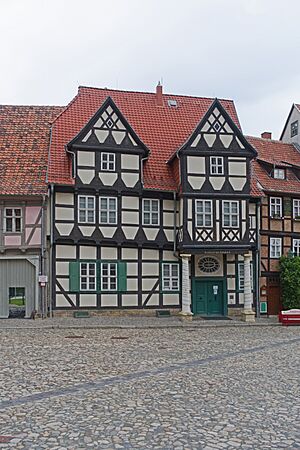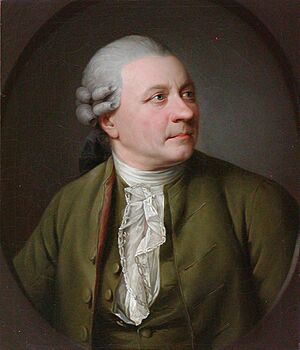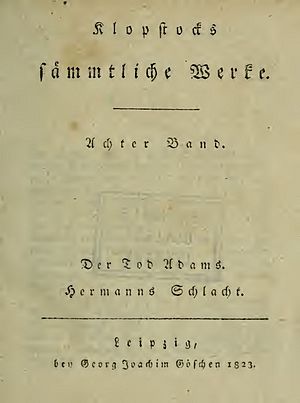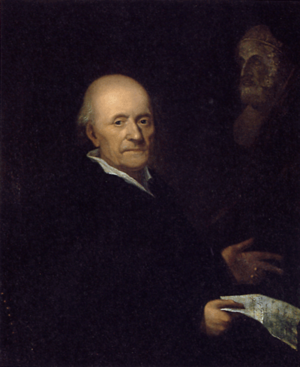Friedrich Gottlieb Klopstock facts for kids
Quick facts for kids
Friedrich Gottlieb Klopstock
|
|
|---|---|

Klopstock by Johann Caspar Füssli (1750)
|
|
| Born | 2 July 1724 Quedlinburg, Holy Roman Empire |
| Died | 14 March 1803 (aged 78) Hamburg, Holy Roman Empire |
| Language | German |
| Genre | |
| Literary movement | |
| Spouse | Meta Moller Johanna Elisabeth von Winthem |
Friedrich Gottlieb Klopstock (born July 2, 1724 – died March 14, 1803) was an important German poet. He is most famous for his long poem called Der Messias ("The Messiah"). Another well-known poem is Die Auferstehung ("The Resurrection"). Parts of Die Auferstehung were used in Gustav Mahler's Second Symphony.
Klopstock helped German literature become more creative. Before him, many German writers copied French styles. He encouraged them to explore new ideas and ways of writing.
Contents
Biography
Early Life and Education
Friedrich Gottlieb Klopstock was born in Quedlinburg, a town in what was then the Holy Roman Empire. He was the oldest son of a lawyer. He had a happy childhood, spending time in Quedlinburg and on his father's estate in Friedeburg.
He was a strong and healthy child, known for being an excellent horseman. When he was 13, he went to a local school in Quedlinburg. In 1739, he attended the famous classical school called Schulpforta.
At Schulpforta, Klopstock quickly became skilled at writing poems in Greek and Latin. He also wrote some good poems and odes (a type of lyrical poem) in German. He first planned to write an epic poem about a German hero, Henry the Fowler. However, he changed his mind after reading Milton's Paradise Lost. He decided to write a religious epic instead.
While still at school, he started planning Der Messias. This poem would later bring him much fame. In 1745, he gave a speech about epic poetry when he left school. He then went to the University of Jena to study theology. There, he wrote the first three parts of Der Messias in prose.
He didn't like Jena, so in 1746, he moved to the University of Leipzig. In Leipzig, he joined a group of young writers. The first three parts of Der Messias were published anonymously in 1748 in a magazine called Bremer Beiträge.
Life in Denmark and Germany
Soon, everyone knew who wrote Der Messias. Klopstock also wrote many odes in Leipzig. One of his most famous is An meine Freunde (1747). After leaving the university in 1748, he worked as a private tutor. He fell in love with a cousin, but she didn't feel the same way.
In 1750, he was happy to accept an invitation to visit Johann Jakob Bodmer in Zürich. Bodmer was the person who translated Paradise Lost into German. Klopstock was welcomed warmly and felt much better. However, Bodmer was surprised that the young poet was interested in worldly things, and their friendship cooled.
Around this time, Frederick V of Denmark invited Klopstock to live in Copenhagen. The king offered him money so he could finish Der Messias. Klopstock accepted the offer.
On his way to Copenhagen, Klopstock met Margareta Moller in Hamburg. She was a big fan of his poetry. They married in 1754. She was known as "Cidli" in his odes. Sadly, she died in childbirth in 1758. Klopstock was heartbroken, and his sadness is clear in the fifteenth part of Der Messias.
After her death, Klopstock published his wife's writings. These writings showed she was a kind, sensitive, and very religious person.
Later Years and Messias Completion
Klopstock became very sad after his wife's death. He found it hard to come up with new ideas for his poems. He continued to live and work in Copenhagen. He became interested in Norse mythology, thinking it should replace classical stories in German poetry.
In 1770, he moved to Hamburg with Count Bernstorff, a Danish minister. Klopstock kept his pension and his title as a councillor. In 1773, the last five parts of Der Messias were finally published.
In 1775, he traveled south and met the famous writer Johann Wolfgang von Goethe. Klopstock spent a year at the court of the Margrave of Baden in Karlsruhe. In 1776, he returned to Hamburg. He lived there for the rest of his life, receiving pensions from both the Margrave and the King of Denmark.
In his final years, Klopstock lived a quiet life, as he always preferred. He spent time with close friends and studied languages. He was excited about the American War of Independence and the start of the French Revolution. The French Republic even made him an honorary citizen. However, he was horrified by the violence of the Revolution and returned the honor.
When he was 67, he married again. His second wife was Johanna Elisabeth von Winthem, a widow and a niece of his first wife. She had been a close friend for many years. Friedrich Gottlieb Klopstock died in Hamburg on March 14, 1803. He was buried with his first wife in the churchyard of Ottensen.
Works
Der Messias
Der Messias was Klopstock's dream to become an epic poet. The main idea of the poem is the Redemption of humanity. He used Christian stories and beliefs to tell this epic tale.
Milton's Paradise Lost was a big inspiration for Klopstock when he wrote Der Messias. The poem took him 25 years to finish. When it first came out, people were very excited about it. It has been translated into 17 languages and inspired many other writers.
Odes and Dramas
Klopstock's odes allowed him to show his unique talent. Some of his odes were inspired by Norse mythology. Others focused on religious themes.
Some of his most famous odes include An Fanny, Der Zürchersee, and Die Frühlingsfeier (a beautiful religious ode). He also wrote dramas. In plays like Hermanns Schlacht (1769) and Hermann und die Fürsten (1784), Klopstock celebrated the ancient German hero Arminius. He also wrote plays based on stories from the Old Testament, such as Der Tod Adams (1757) and Salomo (1764).
His hymn "Die Auferstehung" is said to have inspired Gustav Mahler's Second Symphony. Mahler used parts of the hymn and added his own verses to it.
Prose Works
Klopstock also wrote non-fiction works. These include Die Gelehrtenrepublik (1774), Fragmente über Sprache und Dichtkunst (1779), and Grammatische Gespräche (1794). In these books, he made important contributions to the study of language and the history of German poetry.
Goethe's Description
The famous German writer Johann Wolfgang von Goethe wrote about his impression of Klopstock in his autobiography. Goethe said Klopstock was small but well-built. He had serious and proper manners, but he wasn't overly formal. He spoke intelligently and was pleasant to talk to.
Goethe felt that Klopstock carried himself with the dignity of someone who had an important moral mission. He could talk easily about many topics, but he usually avoided discussing poetry or literature.
Legacy
Klopstock greatly helped German poetry. He made its vocabulary richer and paid close attention to how words sounded and flowed. He freed German poetry from relying only on the Alexandrine verse style. This made him the founder of a new era in German literature.
Because of his work, later poets like Friedrich Schiller and Johann Wolfgang von Goethe were able to develop their own artistic styles. An 800-year-old oak tree in Denmark, where Klopstock spent time, was named after him.
See also
 In Spanish: Friedrich Gottlieb Klopstock para niños
In Spanish: Friedrich Gottlieb Klopstock para niños





